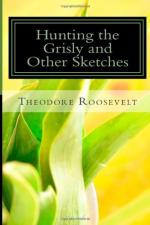Before the cold weather sets in the bear begins to grow restless, and to roam about seeking for a good place in which to hole up. One will often try and abandon several caves or partially dug-out burrows in succession before finding a place to its taste. It always endeavors to choose a spot where there is little chance of discovery or molestation, taking great care to avoid leaving too evident trace of its work. Hence it is not often that the dens are found.
Once in its den the bear passes the cold months in lethargic sleep; yet, in all but the coldest weather, and sometimes even then, its slumber is but light, and if disturbed it will promptly leave its den, prepared for fight or flight as the occasion may require. Many times when a hunter has stumbled on the winter resting-place of a bear and has left it, as he thought, without his presence being discovered, he has returned only to find that the crafty old fellow was aware of the danger all the time, and sneaked off as soon as the coast was clear. But in very cold weather hibernating bears can hardly be wakened from their torpid lethargy.
The length of time a bear stays in its den depends of course upon the severity of the season and the latitude and altitude of the country. In the northernmost and coldest regions all the bears hole up, and spend half the year in a state of lethargy; whereas in the south only the she’s with young and the fat he-bears retire for the sleep, and these but for a few weeks, and only if the season is severe.
When the bear first leaves its den the fur is in very fine order, but it speedily becomes thin and poor, and does not recover its condition until the fall. Sometimes the bear does not betray any great hunger for a few days after its appearance; but in a short while it becomes ravenous. During the early spring, when the woods are still entirely barren and lifeless, while the snow yet lies in deep drifts, the bear, hungry brute, both maddened and weakened by long fasting, is more of a flesh eater than at any other time. It is at this period that it is most apt to turn true beast of prey, and show its prowess either at the expense of the wild game, or of the flocks of the settler and the herds of the ranchman. Bears are very capricious in this respect, however. Some are confirmed game, and cattle-killers; others are not; while yet others either are or are not accordingly as the freak seizes them, and their ravages vary almost unaccountably, both with the season and the locality.
Throughout 1889, for instance, no cattle, so far as I heard, were killed by bears anywhere near my range on the Little Missouri in western Dakota; yet I happened to know that during that same season the ravages of the bears among the herds of the cowmen in the Big Hole Basin, in western Montana, were very destructive.




